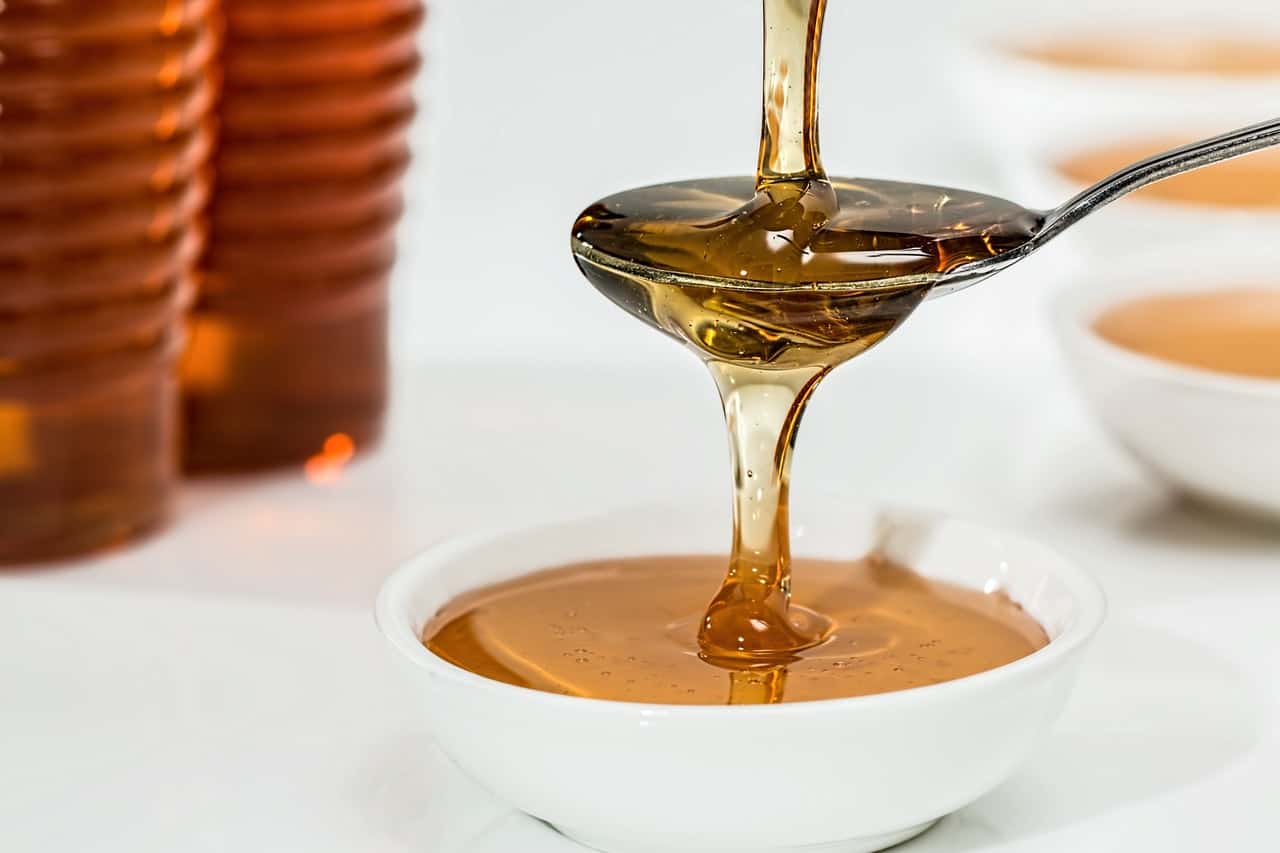Sourwood honey is the best honey in overall countries but mostly in America. This honey already has a winner in three contests. The sourwood honey is formed in North Carolina, North Georgia, and Tennessee mountains. This is also harvested between June and July when sourwood trees get beautifully bloomed. Do you know what sourwood honey is?
Sourwood honey has got the name because its leaves have a sour taste. It is being used as a thirst quencher for mountain climbers and hikers. Sourwood honey taste doesn’t have a sour taste. The sourwood honey has a very out-of-the-box taste:- buttery, floral, and aromatic. It is also unlike the dark taste of the tulip trees. The sourwood honey has an amber color and is ultra-light. The flavor of this honey is very favorable, and this is also mostly desired by food connoisseurs across the world. This honey also smells like a combination of anise, cloves, and cinnamon. Let’s learn what sourwood honey is.

Contents
Sourwood Honey Nutrition Facts
When natural and raw sourwood honey is sourced, you will make the most benefits from the honey. This is because similar to milk, honey is also pasteurized for helping to extend the shelf life. However, it destroys most of the beneficial vitamins, enzymes, and nutrients in sourwood honey. That’s why it is more helpful to stick with raw honey.
Only one tablespoon, of sourwood honey, carries sixty calories, zero grams of protein and fat, and seventeen grams of carbs. This honey is very rich in mineral and vitamin profiles. It is rich in vitamins E, D, C, and A. In addition, however, it is rich in Vitamin B, which includes pantothenic, riboflavin, niacin, thiamine, and Amino acids. Vitamin B plays a vital role in a person’s metabolic process, brain function, and energy levels. Vitamin B is combined with carbohydrates already in honey, making it a significant boost for the body.
Sourwood honey, like most honey, will contain trace minerals like zinc, potassium, phosphorus, magnesium, iron, and calcium that are crucial for your health.
Sourwood Honey Health Benefits
All the honey varieties possess significant health benefits, and all these benefits are unique to amazing sourwood honey. Let’s have a look at Sourwood honey’s health benefits.
1. Wound healing and anti-inflammatory properties:
Honey is also used to heal wounds from ancient times. The properties of anti-inflammatory and antibacterial promote the healing process of the wound.
When the honey is applied to our wound, the pH acidic of the honey in-between somewhere 3.2 to 4.5 also encourages blood to release oxygen, and it is quite beneficial for healing wounds. Acidic pH even reduced the presence of the protease. It is usually present between pH4 level and above. Proteases are the enzymes that break down protein into peptides and amino acids. High protease activity can also impair wound healing and make the wound harder to recover.
However, the natural sugar of Sourwood honey even contributes to its healing properties. Sugar also has osmotic effects, which draw out the water from tissues. It helps to soak up moisture which allows bacteria cells to survive. When our wound doesn’t contain bacteria, it will heal more quickly.
2. High in Antioxidants:
Sourwood honey is full of antioxidants, including amino acids, organic acids, phenolic acids, flavonoids, carotenoid derivatives, etc. The antioxidants have various preventative effects on the health diseases such as neurological degeneration, inflammatory disorders, aging, cardiovascular diseases, and cancer. Therefore, Sourwood honey is known as one of the best health benefits sources.
The antioxidants will even help you fight the free radicals of the body. The free radicals will come from the normal process of metabolism, which occurs in the body. Still, it can get generated from external variables, including poor diet, air pollutants, and UV radiation. It is also known as the Sourwood honey cancer cure.
So, if you are protecting this oxidative reaction from occurring by consuming honey, a person can keep up the tissues healthier for a longer time.
3. Relieving cough and cold symptoms:
The sourwood honey’s antimicrobial, antibacterial, and antioxidant properties make it a perfect medicine for fighting coughs, colds, and other symptoms. Its dense nature even helps to soothe the sore throat naturally, and the high nutrient profile will help you benefit the immune system. It does not even help recover it faster but even prevents chances of the common cold.
In a study, 150 children were suffering from coughing. But, it is found that honey did a much better job easing the coughs and improving sleep than popular cough medicines.
4. Boosts the energy:
Sourwood honey will give instant benefit to the energy level. Because of the natural sugars present in the honey, it will offer a healthier source of energy and calories wherever your body needs the most. The sourwood honey cab even fights out the fatigue. In addition, it helps to satisfy the body’s cravings for something which tastes sweet.
It is because of a chemical compound of honey, which is even composed of glucose and fructose sugars, easier for digestion by the body. If it gets digested, our body will easily convert honey into energy. This is even calorically dense of twenty grams of honey, providing three percent of the daily energy requirements.
Where Did Sourwood Trees Grow?
It is pretty native including North Georgia and the mountains of North Carolina, and the upper elevations of South Carolina. You might see the trees blooming in various regions also. The sourwood tree is very rarely noticeable if it is not in bloom. You can find the tree growing in the foothills and mountainsides.
The white-shaped flowers get opened, and the tree is very easily recognized. If someone has sourwood trees on their farm, they are fortunate. This tree will create a fantastic display during June and July through its blooming.
Higher elevations of the Appalachia boast even more than the nectar that produces the sourwood bloom than foothills. This tree is tiny under the story trees. But, it can even reach out to great heights where the growing condition is best.
In fall, leaves come alive with color. It is usual to see purple, red and yellow leaves on a single tree. The excellent, sourwood, ornamental tree loves the acid oils. You will also see the growth of ridges above the streams.
How Sourwood Honey Produced?
How do the beekeepers manage the bees to get mono-floral honey-like sourwood? Most honey is a mixture of nectar from various blooming plants. The standard hive has consisted of honey supers which will hold up some excess honey. When the tree around the bee yard starts to bloom, it will remove the partially filled honey supers and put the empty box in place. In various weeks of bloom, the honey is produced called sourwood. Few other sources are available so that the bees work in color.
Honey Production Will Vary from Year to Year
While the trees bloom and grow in the areas outside the southeast, the tree doesn’t produce more nectar for honey production. The nectar production of the sourwood trees is also linked to the elevation. Higher regions of the mountain produce the nectar than the foothills. Central and southern Appalachians come alive with the sourwood blossoms from June to July. In South Carolina, you might find out the trees blooming in mid-state areas of Columbia.
But the little sourwood honey is also produced in Pickens South, located in the northern parts of the state. The sourwood trees produce the best at an altitude of 1000 feet, at 1100 feet above sea level.
Why is Sourwood Honey So Unique?
The lady aviator experiences the two flows of honey in the Appalachian Mountains. The red maple kicks the brood season in March. The bees are primarily sourcing for the pollen, which is very rich in protein and produces little nectar. Nectar flows start in earnest with the black locust, dandelion, holly, and black gum blooming in the first half of May. The raspberry, tulip, and permission poplar bloom later in the month. It is also a time when various wildflowers start to blossom. Around two hundred pollen markers in the wildflower reflect a wide variety of flora. It is also known as the Sourwood honey cancer cure.
Towards the end of May and starting of June, sweet and white clover, ladino, tulip poplar, linden, and basswood start to bloom. Ever and efficiently, the honey bees will be traveling the least distance to a great nectar source. We have an abundance of tulip trees surrounding the apiary. Stunningly and single large orange poplar blossom will produce a full nectar tablespoon. The prodigious honey producer, the young twenty feet tulip tree, can also yield the nectar, and that bee reduces to four pounds of the honey. When the tree is blooming, this is unlikely bees will ever forage various plants.
Sourwood trees start to flower in the third week of June, with some blooms which last for four weeks. The lovely bell-shaped and white floret is also abundant in nectar producers. Unlike tulip poplar’s bold mineral and dark rich taste, sourwood bears the unique floral and aromatic honey. The amber and ultra-light color betray the spice and soft anise flavor, making it the most distinctive honey. The honey of sourwood is very remarkable, and it has also won three out of six Apimonda championships of honey contests. It is highly coveted by food connoisseurs around the whole world.
Unfortunately, sourwood trees are an inconsistent producer of honey. It is lower than the normal temperatures and rainfall, affecting the shirt efflorescing. The land development is even dramatically lowering the impressive stands of sourwood trees. help is also coming with reclaiming the West Virginia and Kentucky mining areas, but it is in the nascent stage.
Difference Between the Sourwood Honey and Wildflower Honey
Do you want to know the difference between wildflower and sourwood honey? Then let’s start with the difference.
Wildflower Honey:
In spring, the bees get foraging in the myriad of blooms. Honey, harvested in the early spring, will get slightly another color, aroma, and flavor harvested in the late springs. We also called it Wildflower honey. The unfiltered and raw honey also contains the various properties of the pollen spores, which gives the allergy suffered very much trouble in spring. Minimal exposure to anti-allergens in the honey will help the immune system develop defenses.
Sourwood Honey:
Despite the name, the sourwood tree found in the Appalachian Mountains has mild, anise, spicy and sweet flavor and aroma and minty aftertaste. The Colour is also very light amber. We also remove all earlier honey from hives before sourwood blooms and use the supers to ensure a purer crop than the premium honey.
FAQs
1. Where does the Sourwood honey come from?
Ans. The bees make the sourwood honey from the sourwood blossom nectar.
2. Where is sourwood honey produced?
Ans. The sourwood honey can be made with the trees which bloom above a thousand feet in the mountains of Tennessee and Georgia.
3. Where are sourwood trees found?
Ans. The sourwood is found in southern Indiana, southern Ohio, southwest Pennsylvania, south to southeastern Louisiana, coastal region of Alabama, Mississippi, northwest Florida, and western Tennessee and Kentucky.
4. Why is it called sourwood?
Ans. The sourwood name is derived from the acrid tastes of the leaves, but the tea is made from the leaves and is mostly used by mountain climbers as a thirst quencher.
Conclusion
Here we have discussed the sourwood honey benefits, nutrition facts, Sourwood honey taste, and many other things. Then, you can go through this whole article to understand how it is produced and made. Sourwood honey got its name because of the sour taste of its leaves. It is being used as a thirst quencher by mountain climbers and hikers. Sourwood honey is one of the best honey all over the world. It possesses great benefits for our health, especially if it is taken raw. Finding out natural and raw sourwood honey is quite difficult, but use it for your home purpose if you can get it. Always stick with the natural one instead of the processed one as it will offer you great benefits over the processed ones.
Post You May Like:
- Create Office Fitness Challenge
- Immediate Constipation Relief for Adults
- Purpose and Importance of Basic Life Support


